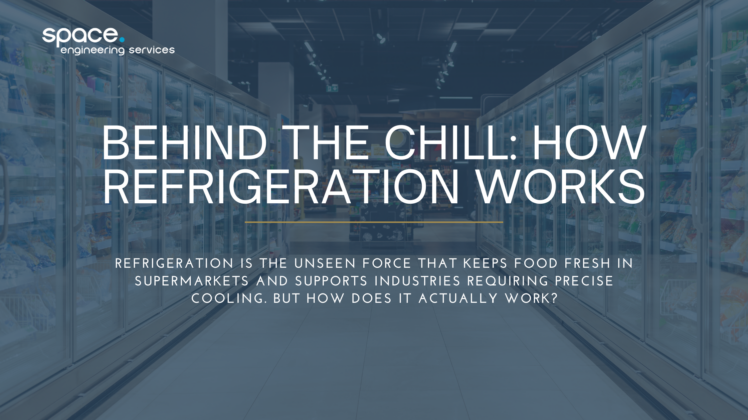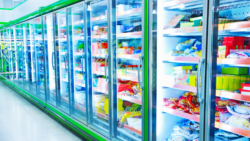
07 Apr 2025
Refrigeration is the invisible force that keeps supermarkets stocked with fresh produce, ensures food distribution centres operate efficiently, and supports industrial processes that require precise cooling. But how does refrigeration actually work? Let’s break it down.
The Science Behind Refrigeration
At its core, refrigeration is all about heat transfer – removing heat from an area to keep it cool. The process relies on a closed-loop system of refrigerants, compressors, condensers, and evaporators to absorb and expel heat. This cycle allows us to maintain controlled temperatures for food preservation, climate-sensitive storage, and industrial cooling.
To explain it in simple terms, let’s think about your home refrigerator. Imagine you have a box (your fridge) that you want to keep cool. Inside the fridge is the evaporator, the component responsible for cooling. A special substance called refrigerant flows through the evaporator, which is like a special liquid or gas that can easily absorb heat. When the refrigerant moves through the fridge, it absorbs the heat inside and carries it away. This process cools down the air inside the fridge, keeping your food fresh and cold.
Now, here’s how the process works in more detail:
In a supermarket or industrial setting, refrigeration systems are much larger, but the principle remains the same. They work hard to keep a wide range of products at the right temperature, ensuring things like meat, dairy, and frozen goods stay fresh and safe to consume.
Supermarket Refrigeration: Keeping Fresh on the Shelf
Supermarkets rely on an extensive network of refrigeration systems to keep food fresh, safe, and visually appealing. This includes:

Supermarket refrigeration is carefully designed to maintain different temperature zones for various food products, ensuring freshness, safety, and compliance with food regulations. Fresh produce and dairy items are typically stored between 0°C and 4°C, while fresh meat and fish require colder temperatures, around -1°C to 2°C, to prevent bacterial growth. Frozen goods, such as ice cream and ready meals, must be kept at -18°C or lower to maintain quality and longevity.
Retail refrigeration is evolving with more energy-efficient and low-GWP refrigerants to reduce environmental impact while keeping food at optimal temperatures.
Industrial Refrigeration: Keeping Food & Critical Industries Cool
While refrigeration is essential for supermarkets and food distribution, its role extends far beyond retail. Industrial refrigeration is vital for large-scale food processing, cold storage distribution, and other critical industries, including:
Industrial refrigeration systems must meet high-capacity cooling demands, often relying on CO₂-based refrigeration, ammonia systems, blast freezers, spiral freezers, and large-scale cold rooms. These systems are engineered for efficiency, compliance, and long-term reliability, using advanced controls to optimize performance while reducing environmental impact.
With sustainability at the forefront, solutions like CO₂ refrigeration are becoming increasingly popular, offering a lower-carbon alternative to traditional refrigerants.
The Importance of Service and Maintenance

A well-maintained refrigeration system is essential for smooth, uninterrupted operations. Without regular servicing, refrigeration systems can experience performance issues, leading to energy inefficiencies or even complete failure, which could result in spoilage or downtime. Routine maintenance is necessary to ensure systems are running at peak efficiency, and that potential issues are identified and addressed early. At Space Engineering Services, we offer 24/7 service and maintenance support, providing peace of mind that your refrigeration system will be operating at its best around the clock. Our experienced engineers are always ready to respond quickly, ensuring any issues are addressed before they impact your operations, helping you avoid costly disruptions.
Looking Ahead: The Future of Refrigeration
As the demand for sustainable refrigeration grows, the industry is embracing smarter, greener technologies to reduce environmental impact and improve efficiency. From natural refrigerants to AI-driven predictive maintenance, innovation is shaping the future of cooling solutions. At Space Engineering Services, we’re committed to leading this transformation – partnering with retailers and industrial clients to deliver energy-efficient, reliable, and future-ready refrigeration systems.
Refrigeration is more than just keeping things cool – it’s about ensuring freshness, efficiency, and sustainability across industries. As technology advances, so do the opportunities to create smarter, greener, and more reliable refrigeration systems.
Want to learn more about how we’re shaping the future of refrigeration? Get in touch with our team: Contact us.
We’d love to hear from you. Please enter your details in the form below and we will get back to you.
We take your privacy seriously. We will keep your data safe and we won’t pass it on to any third parties.
Please see our privacy policy for more details.